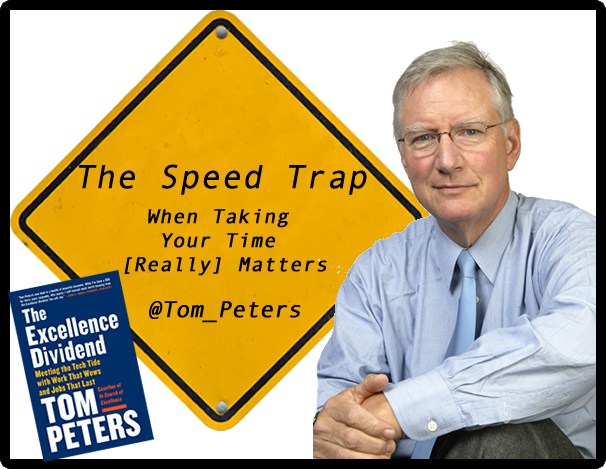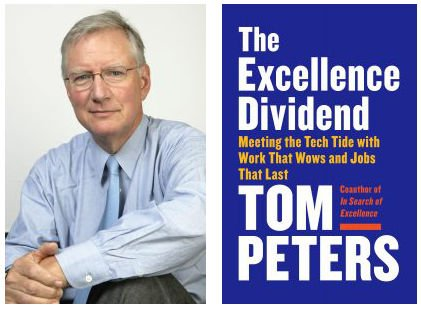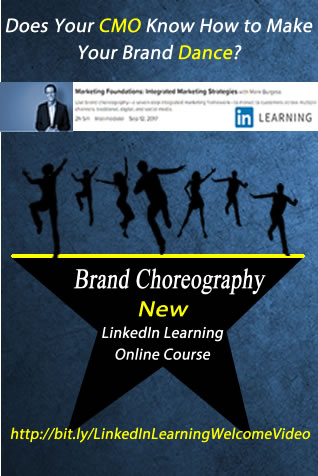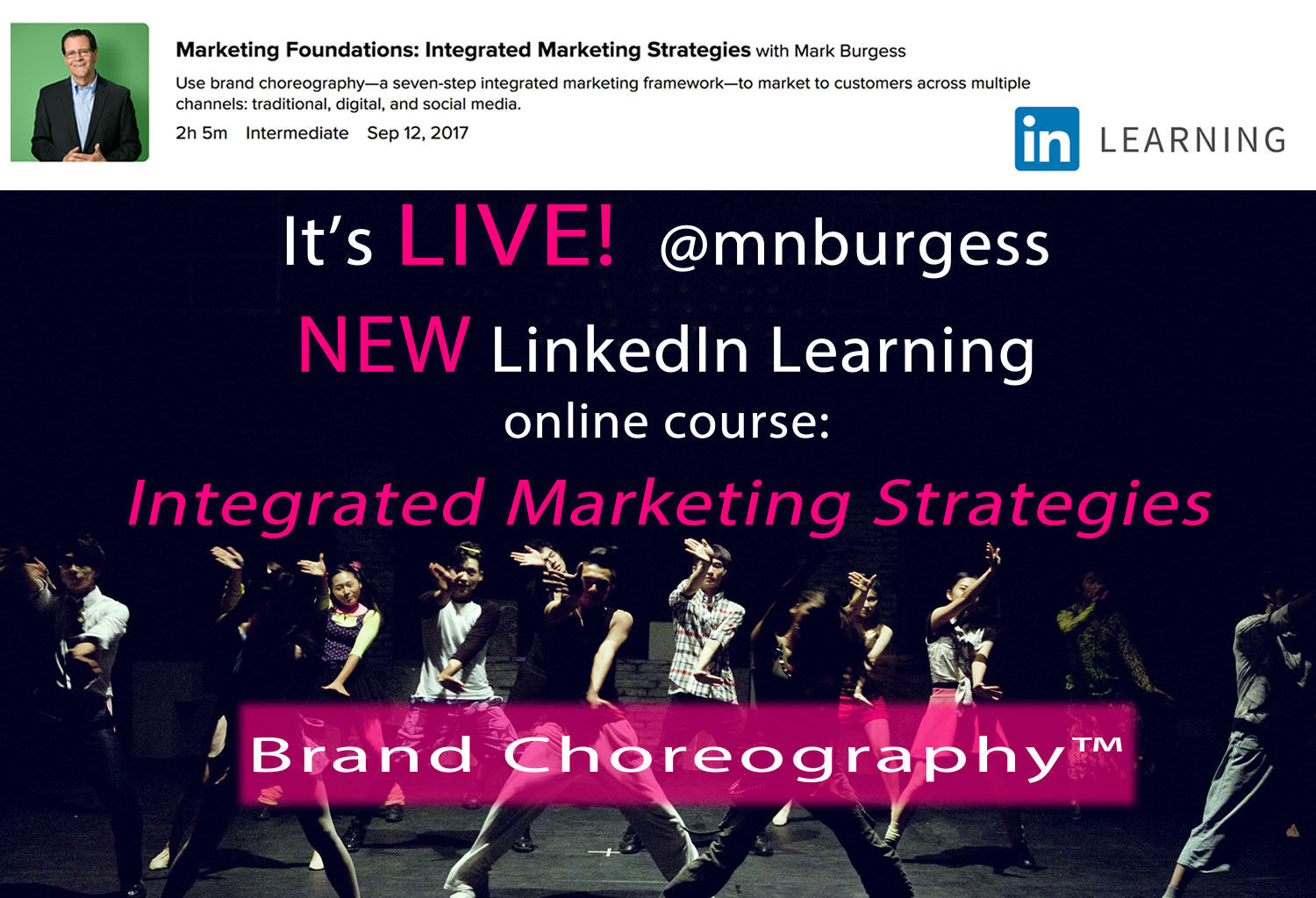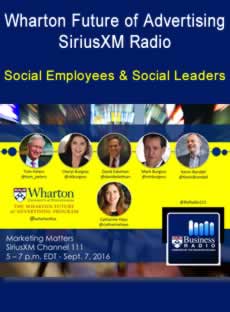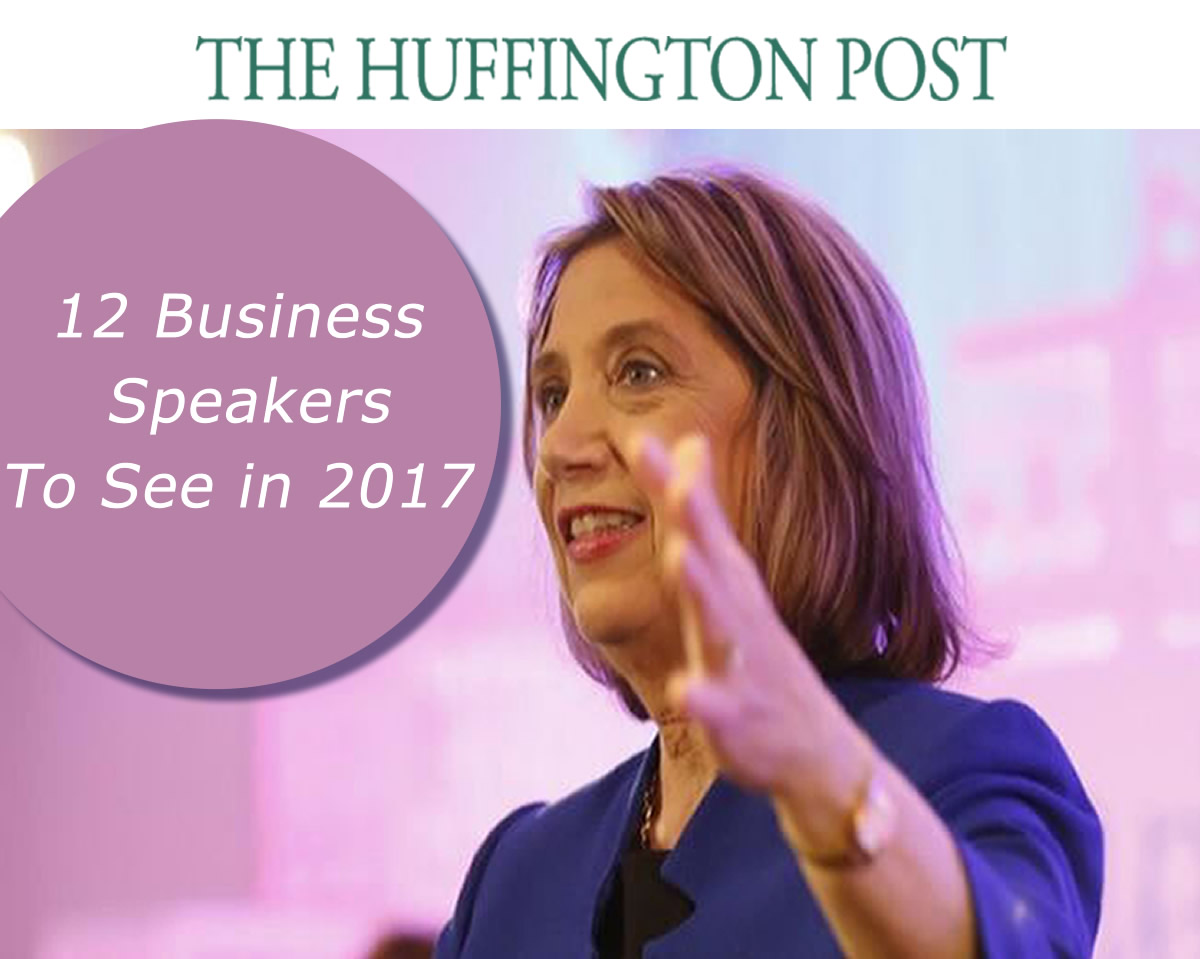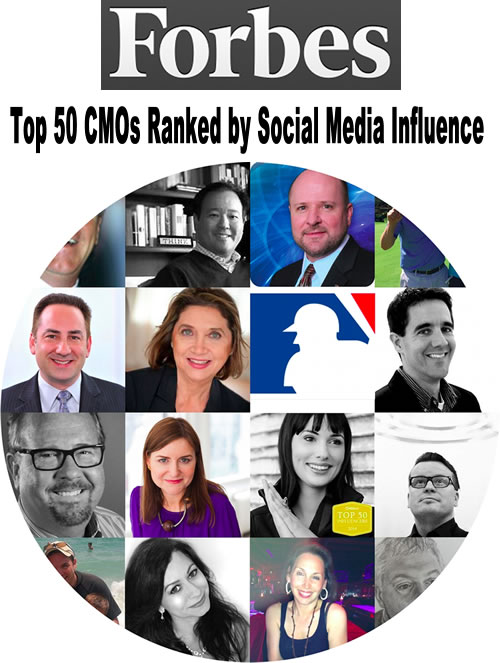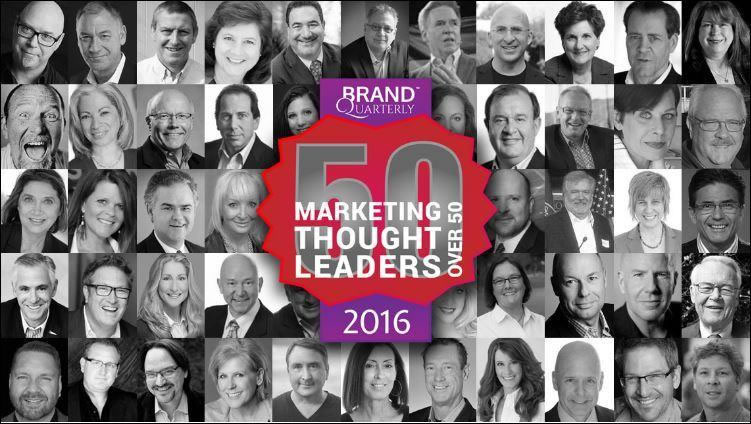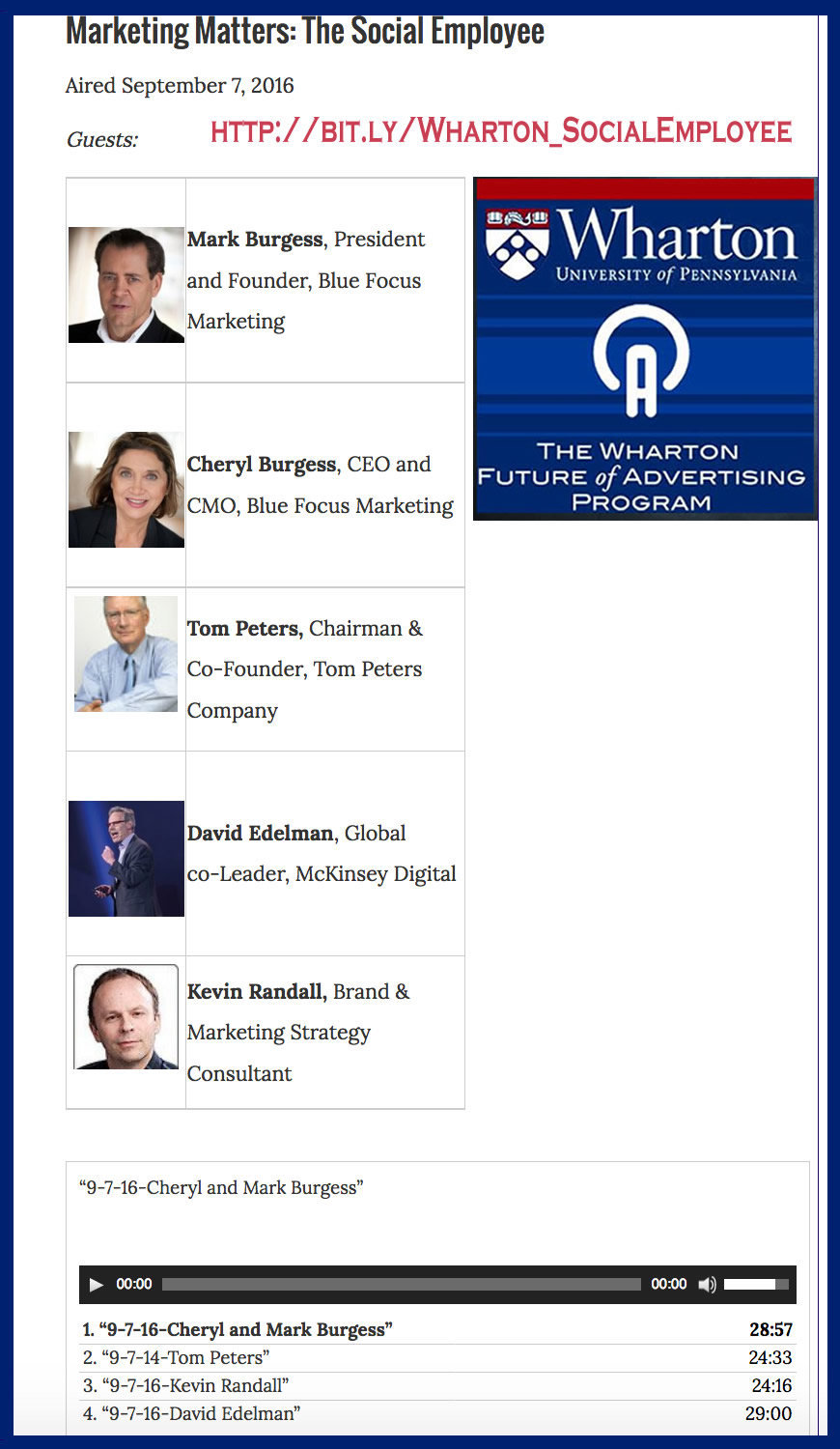In this blog, I am excited to share The Speed Trap: When Taking Your Time [Really] Matters, written by Tom Peters, which is inspired by The Excellence Dividend: Meeting the Tech Tide with Work That Wows and Jobs That Last.
This past week, I was delighted to be part of a small group of professionals with whom Tom chose to share his wisdom and thought leadership, coming on the heels of The Excellence Dividend. So, it is with Tom’s approval, that I happily share The Speed Trap for your reading enjoyment.
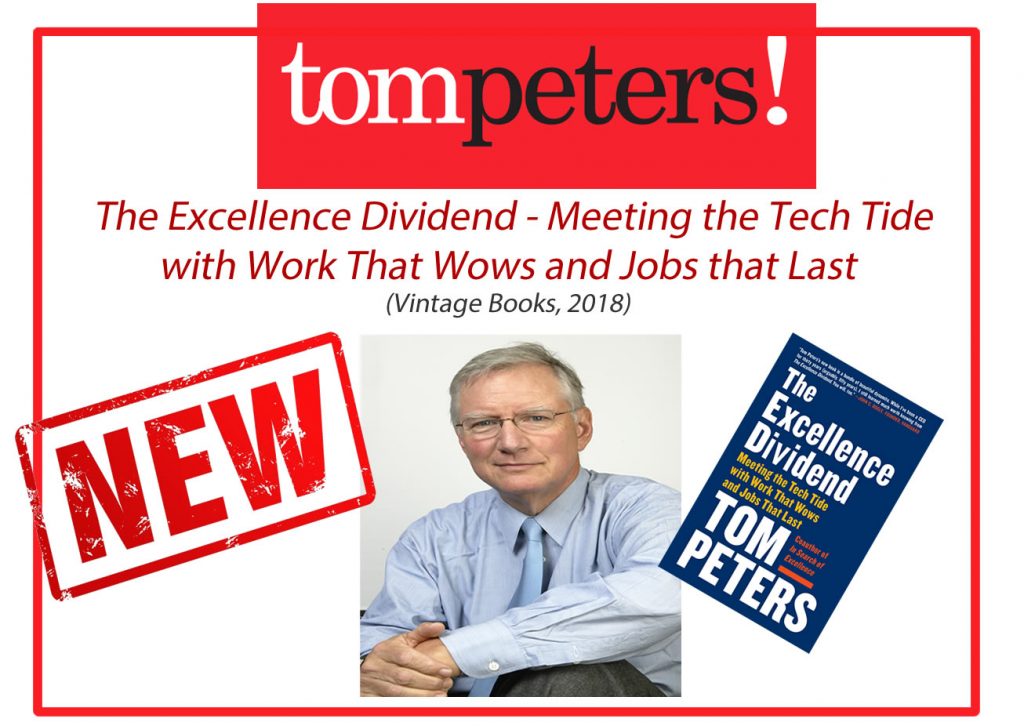
“SPEED.
SPEED IS THE KEY TO PERSONAL SUCCESS.
SPEED IS THE KEY TO ENTERPRISE SUCCESS.
SPEED IS KEY TO LIFE ITSELF.”
SPEED is everything in 2018. Or is it . . . total bullshit?
As usual, Tom has a wonderful way with words and you are in for a special treat. You will learn why “Hard is soft. Soft is Hard.” Find out why all of the so-called “soft stuff” [that is really the “hard stuff”} … takes time. Find out what this all means to you and to your business. And what it is that will truly be remembered.
If I tell you too much I’ll spoil this wonderful read for you. Ok, dive in and enjoy Tom Peters’ The Speed Trap: When Taking Your Time [Really] Matters.
The Speed Trap:
When Taking Your Time [Really] Matters*
*This paper has been, as you will see, inspired by The Excellence Dividend: Meeting the Tech Tide With Work That Wows and Jobs That Last.
Paper was written by Tom Peters @Tom_Peters
“Steve and Jony would discuss corners for hours and hours.”
—Laurene Powell Jobs
My first book, In Search of Excellence, can be summarized in six words:
Hard is soft. Soft is hard.
My next fifteen books can be summarized in six words:
Hard is soft. Soft is hard.
My seventeenth book, just out, The Excellence Dividend, can be summarized in six words:
Hard is soft. Soft is hard.
The translation is simple, though the execution is apparently not so simple, or perhaps more people would have bought in:
“Hard” (the plans, the numbers, the org charts) is “soft.” Plans are more often than not fantasies, numbers are readily manipulated—case in point, super-“quants,” ratings-agency geniuses, and others of their ilk cleverly packaged and gave high safety scores to “derivatives” (and derivatives of derivatives and …) consisting of valueless mortgages—thus spurring the multi-trillion-dollar financial crash of 2007-2008++. And org charts: in practice, they have little to do with how things actually get done.
“Soft” (people, relationships, organizational culture) is “hard.” You get things done, for example, on the basis of your patiently developed network of relationships. You imbed a captivating and effective culture by living and reinforcing “the way we do things around here” day after day after day, in fact, hour after hour after hour—forever. And the focus on people? Here’s the thing, an organization is nothing more and nothing less than “people [our folks] serving people [our customers and communities].” And for the leader, who is fulltime in the people business, it’s all about people [leaders] serving people [our folks] serving people [customers and communities].
Soft is hard. I am taken by this summary, courtesy former Medtronic CEO Bill George: “The capacity to develop close and enduring relationships is the mark of a leader. Unfortunately, many leaders of major companies believe their job is to create the strategy, organization structure, and organizational processes—then they just delegate the work to be done, remaining aloof from the people doing the work.”
All the above amounts to the prelude to this paper. It is 2018. Things are crazy out there and in here, wherever “in here” may be. Technology is evolving by the day—and dire estimates of worker displacement are commonplace. And evolving disruption is piled atop disruption—you might say we all suffer from “disruptionitis.” New competitors with radical strategies are arriving at a record pace. The “millennials” on our payroll want to take over the world during their first week on the job. Etc.
We must adapt … fast. Or, rather:
Fast.
Faster.
Faster still.
Regardless of the task at hand, then, the watchword 2018 is therefore simple:
SPEED.
SPEED IS THE KEY TO PERSONAL SUCCESS.
SPEED IS THE KEY TO ENTERPRISE SUCCESS.
SPEED IS KEY TO LIFE ITSELF.
Or is it?
My view is that speed-for-speed’s-sake is about the most counterproductive* approach imaginable. (*I use counterproductive because it’s impolite to use “stupid”—which is what I really believe.)
While we must indeed evolve and experiment rapidly, the process of getting things done [especially radical-ish things that upset apple carts] is all about people. And working with people to get those interesting things done effectively, well, takes time, in fact lots of time. (And it takes just as much bloody time if you are “Agile certified” as it does if you have not been so blessed.)
(Perhaps you can now better understand why I started this paper—“speed trap”–with a discussion of “Hard is soft. Soft is hard.” Put simply, you cannot speed up the so-called “soft stuff”—to try and do so is a design for disaster. Which is to say it more often than not causes more harm than good. E.g., cross-functional coordination, the be all and end all of getting complex tasks done, slows down to a snail’s pace or goes into reverse if the people in the various functions do not have a degree of colleagueship that can only be accomplished over time—and via many a lunch. [You’d/you’ll see in The Excellence Dividend that I think lunch can cure almost any ill.])
The Speed Trap: Below is a partial list of strategic activities that underpin personal and organization performance — which cannot be done in a flash:
The Speed Trap: Below is a partial list of strategic activities—that underpin personal and organization performance—which cannot be done in a flash:
*RELATIONSHIPS … take time.
*RECRUITING ALLIES TO YOUR CAUSE … takes time.
*READING/STUDYING … take time.
*WAITING [per se] … takes time.
*FIERCE/AGGRESSIVE LISTENING … takes time.
*PRACTICE & PREP FOR ANYTHING & EVERYTHING … takes time.
*MBWA [Managing By Wandering Around] … takes time.
*SLACK IN YOUR SCHEDULE … takes time.
*THOUGHTFULNESS/INSTINCTIVE SMALL GESTURES … take time.
*“THE LAST 1%” OF ANY TASK OR PROJECT … takes time.
*GAMECHANGING DESIGN [spending “hours and hours discussing corners”] … takes time.
*EXCELLENCE … takes time.
At the end of the day (and the list), you can say with certainty:
ALL OF THE SO-CALLED “SOFT STUFF” [THAT IS REALLY THE “HARD STUFF”] … takes time.
Let’s briefly examine each item on the list:
RELATIONSHIPS
Years ago, a top-of-the-heap AT&T systems salesperson said to me, “The great salespersons pay little or no attention to shifting quarterly or even annual incentive programs. They know that their bread and butter is enduring, rock solid client relationships built on trust. And you don’t want to lose that trust by selling the client something he doesn’t need just because sales is pushing it this quarter.”
Selling is based on relationships. Getting things done in your organization is based on relationships—in particular the breadth of your [ever-so-patiently developed] network throughout the company, in every function, and at every level from top to bottom. (Time and again it’s the folks who have a wide and deep network three levels “down” in the organization who perform miracles, seemingly without raising a sweat.) And the strength and ubiquity and reliability of that network is a function of time invested. Lunches. A helping hand with a problem. A kudo for a little task well done. And a dozen dozen other things. It’s funny really. Some marvel that getting even complex things done seems “so damned easy for Mary [or Mark].” So damned easy because of a longterm, patient effort to extend her or his network throughout the entire organization.
Could I say more? Of course. A library full of books has been written on the topic. But I’ll leave it at this:
Whoever invests the most clock time on relationship building and develops the broadest and deepest network wins.
Bottom bottom line: Relationships … take time.
RECRUITING ALLIES TO YOUR CAUSE
In the leadership chapter in The Excellence Dividend I suggest (insist, really) that when it comes to getting interesting things of consequence done, literally 80% of your time should be spent recruiting and developing allies. (Yes, 8-0, damnit.) You are aiming to accomplish something which flies in the face of current practice. You have “enemies” whose applecart you will upset. Even some senior enemies. My line: Only idiots spend time on enemies.
Your goal is not to go head-on-head with those who disagree with you (and who are frequently senior to you). Your goal is to patiently surround the buggers with your merry band of accomplished believers. Believers you have dug out of the far corners of the organization and who have hopped on board with relish. Believers who have run experiments on the new approach and improved and improved the new way of doing things. How do you get such a pirate band together? Well, it takes time, 80% of your time in my view. You recruit those allies by asking around, by asking to go out for a cup of coffee, whatever. (And whatever and whatever.) Bottom line: Ally discovery and development [and maintenance!] takes [oodles and oodles] of … time.
What’s the alternative?
As I see it: There is none.
(It would appear, even three decades later, that I, a pretty junior soul, made a non-trivial impact on Mighty McKinsey—In Search of Excellence was the public face of the shift, but only part of the story. In Search in fact came five years into the project—and during those five years the great majority of my time was spent developing allies, often from the “boondocks,” and often quite junior, from literally all around the world. “Painstaking,” frequent-flying effort would be gross understatement.)
*********
My Allies Riff
LOSERS … focus on [waste inordinate amounts of time/mental energy on] enemies.
WINNERS … ignore enemies, never take the bait, and focus on allies, allies, and more allies.
LOSERS … play defense and obsess on “removing roadblocks.”
WINNERS … play offense, ignore roadblocks, and focus with allies on “small wins” that are positive demos of the “new way.”
LOSERS … make enemies.
WINNERS … make friends.
LOSERS … focus on negatives.
WINNERS … focus on positives.
LOSERS … stick out like a sore thumb, attract flies, and are often in a sour mood and not much fun to be around.
WINNERS … work via allies, develop a band-of-brothers-and-sisters, give full credit to those allies and fashion a personal invisibility cloak.
LOSERS … favor brute force and relish organizational bloodshed.
WINNERS … surround naysayers with allies, positivity, and small-wins-by-the-bushel.
**********************************************************************
There is, of course, a Great Paradox imbedded in this paper. If you do spend the suggested time and effort on, say, ally development and maintenance—then projects will be speeded up by, maybe even dramatically. You could say the Great Paradox goes like this: TO SPEED UP, SLOW DOWN.
READ/STUDY
Indeed there is a lot, and a lot new, going on. The pace is inarguably unprecedented. How can you keep up? Well you probably can’t, at least not entirely. Sure, if you’re a big boss, you’ll hire people with contemporary skills. But that’s not enough either. You need at least to be conversant with what’s coming down the pike. There is only one surefire way as far as I’m concerned: Become a devoted, determined, obsessive student!
At a social dinner, I sat next to a Washington-based investment superstar. The conversation was a casual one. This and that. Out of the blue, my dinner companion said, “Do you know what’s the number one failing of CEOs?” I made a smart-aleck response along the lines of, “Well, I can think of ten major failings, but, no, clue me in on #1.” To which he responded: “They don’t read enough.” The response, frankly, caught me completely off guard. And if you need more of the same, here’s confirmation from Berkshire Hathaway number two, Charlie Munger: “In my whole life, I have known no wise people (over a broad subject matter area) who didn’t read all the time—none. ZERO. You’d be amazed at how much Warren [Buffett] reads—and how much I read.”
In 2018, reading and reading and studying and studying—by hook and by crook, age 22 (just out of university) and at age 75 (me), computer coder or appliance repairman—is imperative. PERIOD. And, uh, reading and reading and studying and studying … take time and cannot be rushed.
(A couple of years ago I decided the tech world had passed me by. I dramatically cut back my schedule and spent the best part of a year with my head in the books, dozens and dozens and more dozens of books. No, I am hardly a pro in the areas I examined—but I have reached the point where I can have an intelligent and informative conversation with even those at the top of the field. My reading “approach”: BRUTE FORCE.)
My [and yours, I hope] reading/studying approach … takes time.
WAIT
Rarely does a single volume flip my worldview upside down. But his one did: Wait, The Art and Science of Delay, by Frank Partnoy.
Mr. Partnoy, in a thoroughly researched book, persuasively argues that to slow-down-and-think-about-it is the very definition of what it means to be human. (Ponder that statement, “what it means …”)
Consider/from Wait:
“Thinking about the role of delay is a profound and fundamental part of being human. … The amount of time we take to reflect on decisions will define who we are. Is our mission simply to be another animal, or are we here for something more?”
“Life might be a race against time, but it is enriched when we rise above our instincts and stop the clock to process and understand what we are doing and why.”
“… computer programmer, investor, writer, painter Paul Graham wrote, ‘The most impressive people I know are all terrible procrastinators.’” (There is an entire chapter in Wait, Chapter 10, titled “At Last, Procrastination.”) (Incidentally, the last chapter, Chapter 12, is titled “Get Off the Clock.”)
No commandments from me will be forthcoming. I am simply suggesting that you take a deep breath (yes, that’s permissible in 2018) and reflect on this idea—and please consider reading Mr. Partnoy’s book.
Quite a mouthful: To delay is what makes us human
And, yes, per the theme of this paper, procrastination/pauses to reflect … take time.
FIERCE/AGGRESSIVE LISTENING
In my massive collection of quotes, this one by former U.S. Secretary of State Dean Rusk is on my Top 5 list: “The best way to persuade someone is with your ears, by listening to them.”
I singled Listening per se out as the topic of a separate chapter in The Excellence Dividend. I thought it was that important. (I almost made it Chapter ONE.) Then I went a step further and suggested that listening per se should be …
Enterprise Core Value #1: “We are Effective Listeners—we treat Listening EXCELLENCE as the Centerpiece of our Commitment to Respect and Engagement and Community and Growth.”
Here’s my sales pitch: An obsession with Listening is:
… the Ultimate Mark of Respect.
… the heart and soul of Engagement and Thoughtfulness.
… the basis for Collaboration and Partnership and Community.
… a Developable Individual Skill. (Though women are, in general, notably better at it than men.)
… the core of effective Cross-functional Communication.
(Which is in turn Attribute #1 of organization effectiveness.)
… the key to Making the Sale.
… the key to Keeping the Customer’s Business.
… the linchpin of Memorable Service.
… the core of taking Diverse Opinions aboard.
… profitable. (The “R.O.I.” from listening is arguably (inarguably?) higher than from any other single activity.)
… the bedrock that underpins a Commitment to EXCELLENCE.
This list of benefits of an obsession with listening may read like a laundry list dashed off in a flash. But I would urge you to go through the items one at a time—and draw your own conclusions: “Ultimate mark of respect? Hmmm. Well … OF COURSE.” “Key to making the sale? Hmmm. Well … OF COURSE.” “Linchpin of memorable service? Hmmm. Well … OF COURSE.” And so on.
And per this paper, listening, really listening, “fierce listening” as author Susan Scott puts it, “aggressive listening” according to Navy ship captain Mike Abrashoff … TAKES TIME!
*******
Aggressive Listening/Captain Mike Abrashoff/
It’s Your Ship: Management Techniques from the Best Damn Ship in the Navy…
“My education in leadership began in Washington when I was an assistant to Defense Secretary William Perry. He was universally loved and admired by heads of state … and our own and allied troops. A lot of that was because of the way he listened. Each person who talked to him had his complete, undivided attention. Everyone blossomed in his presence, because he was so respectful, and I realized I wanted to affect people the same way.
“Perry became my role model but that was not enough. Something bigger had to happen, and it did. It was painful to realize how often I just pretended to hear people. How many times had I barely glanced up from my work when a subordinate came into my office? I wasn’t paying attention; I was marking time until it was my turn to give orders. That revelation led me to a new personal goal. I vowed to treat every encounter with every person on USS Benfold [Abrashoff’s ship] as the most important thing at that moment. It wasn’t easy, but my crew’s enthusiasm and ideas kept me going.
“It didn’t take me long to realize that my young crew was smart, talented and full of good ideas that usually came to nothing because no one in charge had ever listened to them. …
“I decided that my job was to listen aggressively.”
Bottom line: Fierce/Aggressive listening … takes time. [lots of].
(Richard Branson is serious about listening: Fully … ONE THIRD/PART ONE/100+ PAGES … of his most recent book, The Virgin Way: How to Listen, Learn, Laugh, and Lead, is devoted to listening per se. E.g., “The key to every one of our [eight] leadership attributes was the vital importance of a leader’s ability to listen.”)
PRACTICE & PREP FOR ANYTHING & EVERYTHING
Basketball’s John Wooden may have been the best coach of anything, ever. He gave us a lot of well-known sayings, but this one is perhaps my favorite: “I was never much of a game coach, but I was a pretty good practice coach.” Then there’s Winston Churchill’s rule of thumb: one hour of preparation for one minute of a speech. (And mine: two weeks of intense work to get ready for a 45-minute presentation—yes, still, after about 3,000 such presentations.) There are things of marginal importance (doing the dishes?) that can be cut short in my experience, but things that matter require you, first, to win the Great Preparation Game. I’ve long said that among speakers in my world, many are smarter than I am, but none can out-prepare me. Perhaps arrogant, but outsiders say it’s pretty close to the truth.
(In the Leadership chapter of The Excellence Dividend, I suggest that the boss should strive for excellence in every, yes, meeting. And secret #1 of Meeting Excellence? No surprise: preparation. An especially important point, because in my experience boss’ meeting prep leaves a lot—a whole lot!—to be desired; and, hey, like it or not, meetings are what bosses do. Meeting Excellence or bust is my mantra. Anybody listening?)
Preparation? No shortcuts. It may be 2018, and everything may be crazy outside, but in my opinion that cries out for more preparation, not less. (Start today! Prepare like a maniac and make that next meeting a Paragon of Excellence!)
Preparation … takes time (lots of).
MBWA [Managing By Wandering Around]
In some sense, MBWA is the beginning and the end and the middle of the story. Bob Waterman and I discovered it at Hewlett Packard in 1978 (part of the “HP Way”), featured it in In Search of Excellence—and to this day its literal and symbolic importance is unsurpassed in my canon. MBWA stands for being in touch with reality, spending time where the action is, establishing an intimate connection with those who do the organization’s “blocking and tackling.” Most of us still work in spaces with others, and can do MBWA the traditional way. But for those who don’t, the leader of an important project, for example, still needs to find a way to be in direct touch, which might mean a quarterly visit to six countries (damn the cost, pay out of your own pocket if necessary, damn it). And, at the very least, substitute constant Phone MBWA instead of relying on messaging and email—nuance over the phone is 10X more valuable (and human) then a dashed off email or 2-line Message.
Whatever the form, and the more direct the merrier, getting out and about by hook or by crook … takes time.
(In the for what it’s worth department, MBWA is leadership trait #1 of 26 in The Excellence Dividend. I approvingly cite Starbucks’ chief Howard Schultz who religiously visits 25 stores per week—to stay in intimate touch with the true nature of his vast operation.)
(You want my 2-cents worth? MBWA is a daily requirement. PERIOD. And if you don’t get off on MBWA, choose another career path. Truly.)
SLACK IN YOUR SCHEDULE
From Dov Frohman, former Intel exec and father of the Israeli tech industry, in Leadership the Hard Way: Why Leadership Can’t Be Taught—And How You Can Learn It Anyway (Chapter 5, “The Soft Skills of Hard Leadership”): “Most managers spend a great deal of time thinking about what they plan to do, but relatively little time thinking about what they plan not to do. As a result, they become so caught up in fighting the fires of the moment that they cannot really attend to the long-term threats and risks facing the organization. So the first soft skill of leadership the hard way is to cultivate the perspective of Marcus Aurelius: Avoid busyness, free up your time, stay focused on what really matters. Let me put it bluntly: Every leader should routinely keep a substantial portion of his or her time—I would say as much as 50 percent—unscheduled. … Only when you have substantial ‘slop’ in your schedule—unscheduled time—will you have the space to reflect on what you are doing, learn from experience, and recover from your inevitable mistakes. Managers’ typical response to my argument about free time is, ‘That’s all well and good, but there are things I have to do.’ Yet we waste so much time in unproductive activity—it takes an enormous effort on the part of the leader to keep free time for the truly important things.”
I cannot imagine adding anything to this, except my belief that overscheduled bosses who run late to meetings with subordinates (by as little as 30 seconds!) are being rude and disrespectful.
Whether Mr. Frohman’s 50% or a lesser, say, 25%, slack does matters, Big Time—and takes time.
THOUGHTFULNESS/INSTINCTIVE SMALL GESTURES
A harried Southwest Airlines pilot pauses as he gets to the departure gate, goes up to the woman in the first wheelchair in line, and asks her if she’d mind if he took her down the jetway. First time I’d seen that in approximately 7,500 flight legs. (One frequent flyer who heard me tell this story said he’d never actually seen a pilot look at a passenger as he headed down the jetway.) No, taking the wheelchair down the jetway did not take much time. But it did take an attitude (or “culture”) of caring.
And the essence of the “culture of caring” is that you do make the time, no matter how busy you are, to make the small gesture of human connection.
And, believe it, those gestures are the ones that define a “customer experience”—and may linger in your mind for years and years. The great American statesman Henry Clay captured this sentiment perfectly: “Courtesies of a small and trivial character are the ones which strike deepest in the grateful and appreciating heart.” (I used the Clay quote as the epigraph to my last book, The Little Big Things.)
Taking the time to help a colleague as a matter of course, taking a passenger down the jetway, digging deep-deeper into a “little” customer problem or query. It requires that attitude/culture of care and concern and connection. That attitude transcends, and is designed to transcend, “faster, faster, faster, speed, speed, speed.”
That is … it takes time.
“THE LAST 1%” OF ANY TASK OR PROJECT
I am giving a speech, say, early tomorrow, and need to be in the auditorium for a tech check at 6:45 AM. Regardless of the evening before (a client dinner that may have gone on to 10:30 PM), I will wake up more or less like clockwork, with no help from an alarm, at about 2:30 AM. I will have spent days and days perfecting my slide deck and tailoring it to this audience. But now it’s “game time.” I would guess that I make 200 or 300 changes between 2:30 AM and 6:00 AM. Underline this word, take the underlining off that one, and so on—it feels like a monumental change as I run through the presentation and my goals therefore in my head for the umpteenth and final time.
In short, I am an avowed “last 1%” fanatic.
I believe in polish and polish and polish—and sometimes, albeit rarely, I throw half the damn thing out between 2:30AM and 6:00AM. No, I do not have all the time in the world—I’ve got to be downstairs at 6:45AM—but I will wait until the last moment, practically last second, before finally locking the presentation in. Win or lose: It damn well depends on that “last 1%.”
Speed.
Speed.
Speed.
But the last 1%… TAKES TIME … and must be given its due. (And, frankly, I don’t want to work with anyone—or hire anyone—who is not a fellow “last 1% fanatic.”)
GAMECHANGING DESIGN/
DISCUSSING CORNERS FOR HOURS
Recall the epigraph for this paper, courtesy Laurene Powell Jobs, “Steve and Jony would discuss corners for hours and hours.”
More:
“Huge degree of care.” —Ian Parker, New Yorker, on Apple design chief Jony Ives’ approach to creating products
“Expose yourself to the best things humans have done and then try to bring those things into what you are doing.” —Steve Jobs
“In some way, by caring, we are actually serving humanity. People might think it’s a stupid belief, but it’s a goal—it’s a contribution that we hope we can make, in some small way, to culture.” —Jony Ives
“Apple’s great design secret may be avoiding insult. Their thoughtfulness is a sign of respect. Elegance in objects is everybody’s right, and it shouldn’t cost more than ugliness. So much of our manufacturing environment testifies to carelessness.”
—Paola Antonelli, MOMA
Design = Corners
Design = Care
Design = Elegance
Design = The Best of Human Achievement
Design = Contribution to Human Culture
Design = Respect
Design = Thoughtfulness
Design = Avoiding Insult
I am not Steve Jobs. You are not Steve Jobs. And our product is not the next generation iPhone. Yet I fervently believe that the terms above—corners, care, elegance, respect, thoughtfulness, avoiding insult, even “best of human achievement”—fit the next speech I give, the customer-interaction process you follow in your auto repair shop, the character of the new training course you are developing.
Design merits a standalone chapter in The Excellence Dividend—and it is treated as No. 1 of eight value-added strategies in the value-added section of the book.
I think [fervently believe!] there is never any excuse in any activity for less than great design. (E.g., the office picnic honoring Memorial Day—did you hire a local superstar chef to do the hotdogs and spend $250 on a local improv group to put on a show for the kids?)
And great design, well … takes time!
EXCELLENCE
Yes, it’s true that I have been going on about Excellence for almost 40 years now. And my passion grows more intense, not less intense, over time. Particularly today, when I think human-driven Excellence (e.g., “courtesies of a small and trivial character …,” Steve Jobs and Jony Ives’ corners that speak of elegance and care) is the best offense as artificial intelligence, for example, intrudes deeper and deeper into the workplace.
I have given “Tom’s Excellence Lecture [rant]” literally thousands of times—and written hundreds upon hundreds of thousands of words examining Excellence and exhorting one and all to get on the Great Excellence Bus.
It is a hyper-fast paced world.
And the speed therein is madly increasing.
Excellence, however, takes time; and by some, or most, measures cannot be rushed.
I leave it to you to deal with the contradictions of the age. But I do hope you will reflect on the above as you tackle your next project or sales call or public lecture. Take the time to pursue and do Excellence. Don’t get automatically caught in the Speed Trap.
(FYI, as a certified old guy, I promise you it is the Excellence you will remember with pleasure—not the time that you beat a competitor to market with tyrannical behavior toward staff and an embarrassing half-done product or service released to the customer. You may have made some bucks by getting there first, but when you’re my age, you surely won’t remember that episode with pride—and the people you browbeat may remember you, but for all the wrong reasons.)
SPEED TRAP: Excellence. Thinking. Culture. Listening. Relationships. ALL FIVE TAKE [lots of] TIME. Slow down!!!!!
— Tom Peters (@tom_peters) April 5, 2018
“Speed is everything in 2018” total bullshit:
Relationships take time.
Recruiting allies to your cause takes time.
Reading/studying take time.
Practice & prep take time.
MBWA takes time.
Thoughtfulness/small gestures take time.
“The last 10%” takes time.
EXCELLENCE takes time.— Tom Peters (@tom_peters) February 12, 2018
